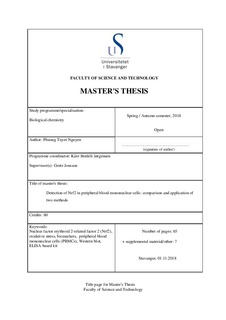| dc.contributor.advisor | Jonsson, Grete | |
| dc.contributor.advisor | Jørgensen, Kåre Bredeli | |
| dc.contributor.author | Nguyen, Phuong Tuyet | |
| dc.date.accessioned | 2019-01-21T12:34:49Z | |
| dc.date.available | 2019-01-21T12:34:49Z | |
| dc.date.issued | 2018-11-01 | |
| dc.identifier.uri | http://hdl.handle.net/11250/2581538 | |
| dc.description | Master's thesis in Biological chemistry | nb_NO |
| dc.description.abstract | Protein nuclear factor erythroid 2-related factor 2 (Nrf2) is a transcription factor that regulates expression of numerous proteins. These proteins protect cells against oxidative stress and reinstate cellular homeostasis. Oxidative stress activates Nrf2, leading to its translocation and accumulation in the nucleus.
Oxidative stress is defined as an imbalance between the production of reactive oxygen species (ROS) and the cellular antioxidant defense capacity, in favor of the ROS. Oxidative stress has been associated with ageing and diseases including cancer, diabetes, atherosclerosis, inflammation, and neurodegeneration.
Since Nrf2 is ubiquitously expressed in all tissues, and Nrf2 levels and cellular location change during oxidative stress, it is desirable to establish a method to evaluate the state of Nrf2 in both cytoplasm and nuclear fractions. Peripheral blood mononuclear cells (PBMCs) can be obtained in a non-invasive manner by blood sampling and are therefore a preferable model system for monitoring Nrf2 levels and localization in response to oxidative stress. At Stavanger University Hospital, biomarkers such as protein carbonyls (PC), malondialdehyde (MDA), and advanced oxidation protein products (AOPP) in blood samples from patients have been used in different studies to assess oxidative stress induced by diseases. Nrf2 determination, if successful, can then become a supplementary test in addition to the tests of the aforementioned conventional biomarkers.
In this research, Western blot and an enzyme-linked immunosorbent assay (ELISA)-based TransAM Nrf2 kit were utilized for the detection of Nrf2 in PBMCs. Moreover, purity of the fractions was also determined with Western blot. The results from the purity determination indicated some contamination in the nuclear fractions, suggesting further optimization of fractionation protocol used. Despite that limitation, the results showed it was possible to use Western blot and the ELISA-based TransAM Nrf2 kit to detect and measure Nrf2 level in different cellular fractions of PBMCs. | nb_NO |
| dc.language.iso | eng | nb_NO |
| dc.publisher | University of Stavanger, Norway | nb_NO |
| dc.relation.ispartofseries | Masteroppgave/UIS-TN-IKBM/2018; | |
| dc.rights | Navngivelse 4.0 Internasjonal | * |
| dc.rights | Attribution-NonCommercial-NoDerivatives 4.0 Internasjonal | * |
| dc.rights | Attribution-NonCommercial-NoDerivatives 4.0 Internasjonal | * |
| dc.rights.uri | http://creativecommons.org/licenses/by-nc-nd/4.0/deed.no | * |
| dc.subject | biological chemistry | nb_NO |
| dc.subject | biologisk kjemi | nb_NO |
| dc.subject | biokjemi | nb_NO |
| dc.subject | oxidative stress | nb_NO |
| dc.subject | biomarkører | nb_NO |
| dc.title | Detection of Nrf2 in peripheral blood mononuclear cells: comparison and application of two methods | nb_NO |
| dc.type | Master thesis | nb_NO |
| dc.subject.nsi | VDP::Matematikk og Naturvitenskap: 400::Basale biofag: 470::Biokjemi: 476 | nb_NO |

